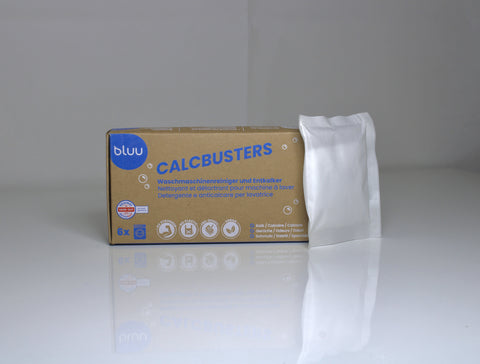Has your favorite black shirt or smart new business trousers turned into a seemingly unkempt item of clothing with indefinable, light-colored stains during washing? What may initially cause you to gasp in horror or have a minor panic attack is actually not so bad. Because you can prevent these nasty white stains on your dark or black clothes effectively and sustainably with a few tips. How? Find out more in this article!
White residue on dark laundry? You're not alone with this problem!
We've all been there: the black laundry comes out of the machine smelling pleasant - but what is it? The freshly washed clothes are covered in white streaks and light-colored stains! So what to do? First of all, it is advisable to keep calm and investigate the cause. As the stains are often caused by limescale deposits or detergent residues in the washing machine, you can easily remedy the problem.

Detergent residues in the machine cause light-colored stains on clothes!
One of the most common reasons for light-colored residues on dark garments is detergent residue in the machine. These so-called detergent stains occur when the detergent does not completely dissolve in the machine during the washing process. With each wash, more residue remains and builds up in the drum and detergent compartments. This often happens when too much laundry is stuffed into the machine and the water cannot circulate sufficiently. If too much detergent is used, deposits can also build up in the machine, which ultimately lead to white stains on the clothes. Therefore, reduce both the amount of laundry and the amount of detergent - this will effectively prevent light-colored stains on your black clothes!
Limescale deposits often also leave white stains on dark garments
It's not just the amount of laundry and the wrong amount of detergent that can lead to light-colored stains on your black garments: water that contains too much limescale can also be the culprit! The higher the limescale content, the harder the water. A high limescale content causes limescale residue to build up in the machine and also in your clothes. This color change is usually not noticeable on light or white items of clothing, but it is all the more noticeable on dark or black fabrics! The washing temperature also has an influence on the limescale residue in the machine.
Basically, the warmer the washing water, the more limescale can build up in the washing machine and the more often you will see unsightly white stains on your laundry!
What can you do about it? Find out about the hardness of the water directly from your local authority. The relevant institutions can provide you with information about the water hardness. Depending on whether the water in your area is classified as "soft", "medium" or "hard", you can adjust the amount of detergent according to the packaging instructions.
Preventing white stains on laundry: these tips will keep your laundry nice and dark!
Light-colored stains on dark laundry are anything but pretty - but fortunately, you can quickly and easily remedy the problem with these tips!
This helps against light stains on dark laundry:
- Descale the machine with calcbusters
- Dose detergent correctly
- Wash on the wrong side
- Home remedy as a "savior in need"
Descaling the washing machine with calcbusters
To prevent light-colored stains on black laundry, you should descale your washing machine regularly. Our calcbusters are particularly suitable for this, as they are not harmful to the machine or the environment and also leave a pleasantly fresh scent.
Get the calcbusters.

Water softener or washing soda effectively remove residues
There are various ways to remove white limescale stains from clothing. Sometimes a new short wash cycle is enough to make the residue disappear. If this trick doesn't work, you should consider using water softener or ecological washing soda in the future. Washing soda is available inexpensively at the drugstore and is a really great everyday helper!
Depending on the degree of soiling, one to two tablespoons of it - together with a small amount of washing powder - is enough to prevent annoying soiling caused by limescale. However, also pay attention to the manufacturer's individual instructions, which you can find on the back of the packaging or on the instruction leaflet. This not only saves valuable resources such as water and detergent, but also does your black clothes and therefore yourself a favor.
It's all about the dose: Too much detergent can cause stains
Have you ever thought about how much detergent you use for each wash cycle and how much is actually necessary? Many people simply dose detergent by feel, without following the manufacturer's recommendations. This can lead to unsightly stains on dark clothes. As there is no universal answer to the question of the right amount of detergent, it is all the more important to read the detergent packaging! This is where you will find valuable information about the respective product and often also recommendations on the amount of detergent for different levels of soiling or water hardness.
If you use the dosage guide that is often included, there is hardly anything that can go wrong. Ideally, you should use an ecological detergent that leaves no residue in the machine or on the garments.
By the way: With our bluu washing strips make dosing very easy. Add 1 to a maximum of 2 sheets of washing strips with every wash.
Home remedies and simple tricks against white residue on dark clothing
So that you no longer have to worry about white stains on your dark laundry in future, there are other practical application tricks.
For example, you can wash dark laundry on the wrong side to prevent residue on the visible right side. If it's already too late for this and white stains are still visible on your favorite black shirt, you should try shaking it out vigorously. Careful brushing with a clothes brush or rolling out with a lint roller has also freed many a black garment from ugly white stains.

Are you curious and want to find out more about removing stains or the proper care of silk and linen and linen? In our blog you will find more exciting information on the topic!




